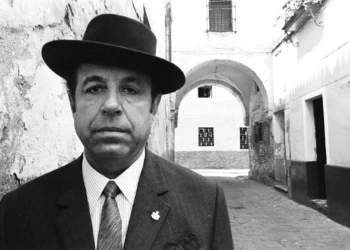 16th Festival de Jerez 2012 16th Festival de Jerez 2012
Mercedes Ruíz “Baile de palabra”
|
|
Text: Estela Zatania THE BEST OF INTENTIONS RAFAEL DE UTRERA – Video Rafael Usero Vilches, “Rafael de Utrera”, is another singer formed in the specialty of singing for dance, who came to the Palacio Villavicencio to show his capability as solo singer. Nowadays, when the town of Utrera, famous for flamenco singers, has lost its most important interpreters, Rafael is one of the few whose artistic name includes the town’s name. However, his singing is quite different from the line we associate with people like Fernanda, Bernarda and Perrate, although in his carefully selected verses, the singer pays tribute to the late great singers of Utrera. His way of singing, the delivery, indeed Rafael de Utrera’s whole approach, is a brave quest with the clear goal of contributing something of his own. Sporting a flashy hot pink tie, admitting to feeling nervous and expressing his thanks to Fernando de la Morena for his support, he opened the recital with a cantiña of Pinini to remember his town, and alegrías de Cádiz. His voice is high-pitched, brilliant and swift as mercury, quite apt for the malagueñas with abandolao ending he then interpreted. In tientos, Rafael de Utrera gave back the solemn identity this cante had always had until it became fashionable to use it as a mere introduction to the lively compás of tangos. Soleá apolá had a sort of intensity that was relieved by the subtle percussion of Paquito González. A version of La Leyenda del Tiempo came off as overkill in this venue normally reserved for traditional acoustic cante, and the same could be said of the singer’s interpretation of the song “Señorita” which was popularized decades ago by Enrique Montoya; too histrionic for the sober ambience of the intimate room. Siguiriyas in the high tone of six “por medio”, elaborated to the point of almost turning it into a song, taranta and bulerías, all highly stylized, rounded out the singer’s recital. The guitar-playing of José Quevedo “El Bola” who accompanied the singer, is full of musicality and original details, clever dissonances and unexpected sounds, always with good taste, subtlety and knowledge.
MERCEDES RUIZ “Baile de Palabra” – Video Wednesday there was no show at the Villamarta theater, and the work “Baile de Palabra” by Jerez dancer Mercedes Ruiz was presented at the smaller-scale Sala Compañía in the first of two programmed performances. The current economic situation is bringing shows which are more and more humble in scope – if last year Mercedes took her medium-format work “Perspectivas” to the Villamarta, this year she got back to basics with “Baile de Palabra” which, in addition to the dancing of Mercedes herself, has only a voice, a guitar, and that’s it. And it should have worked…with good cante in the person of the fine David Lagos, good guitar-playing from the equally outstanding Santiago Lara and Mercedes’ dancing, all the necessary ingredients were there. But somehow it didn’t come together. Perhaps it was overly contrived for the physical limitations of the Sala Compañía. The skimpy illumination, the black wardrobe, the empty stage, the reduced cast…it all begged for life and movement, but Mercedes chose to offer silence and slow-motion. Silences that were not prologues, but ends unto themselves, long maudlin numbers…absence of movement…long guitar introductions…flawed transitions. The dancer allowed us the visual relief of a white bata de cola for petenera, but there was no energy. She gave a demonstration of her castanet technique, but there was no energy. More silence and darkness. She wore black trousers and a black bolero jacket for caracoles; what could have been a luminous dynamic moment, fell flat. And all the while, David Lagos giving his all, multiplying himself, cheering himself on in an impressive array of cantes…pregón, cabales, granaína, classic cuplé…at least three times alone and up front without guitar accompaniment or palmas, even dancing bulerías alone. I think there’s a lesson to be learned: the lower the budget, the more you need to depend on straightforward dance with no experimentation.
|

























